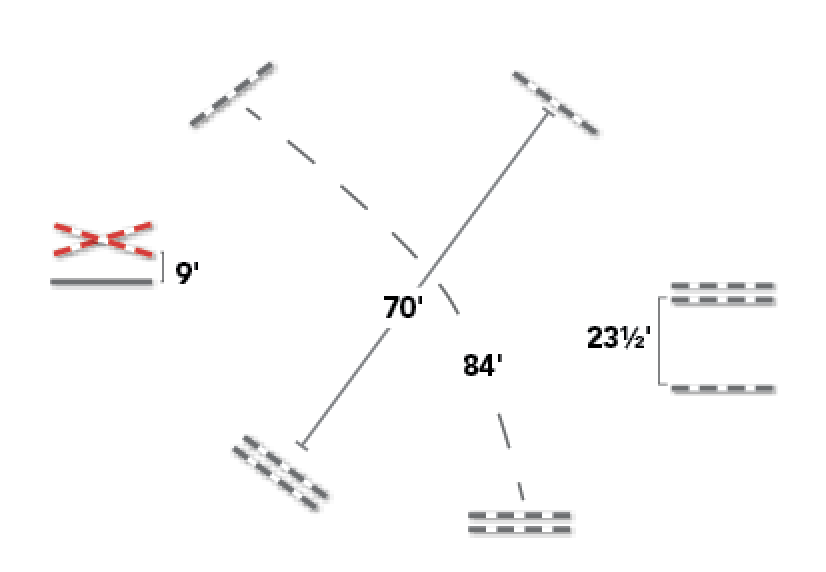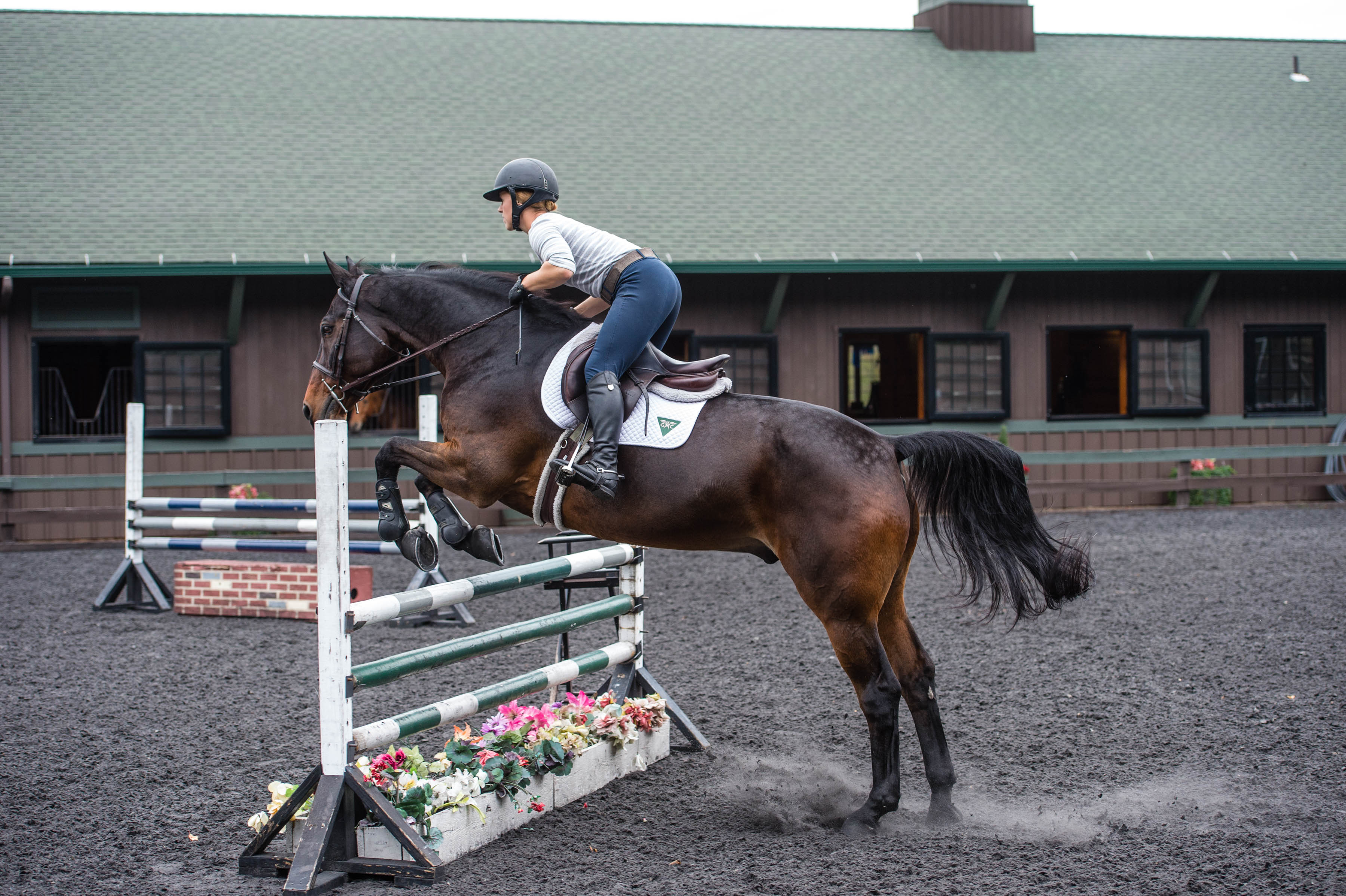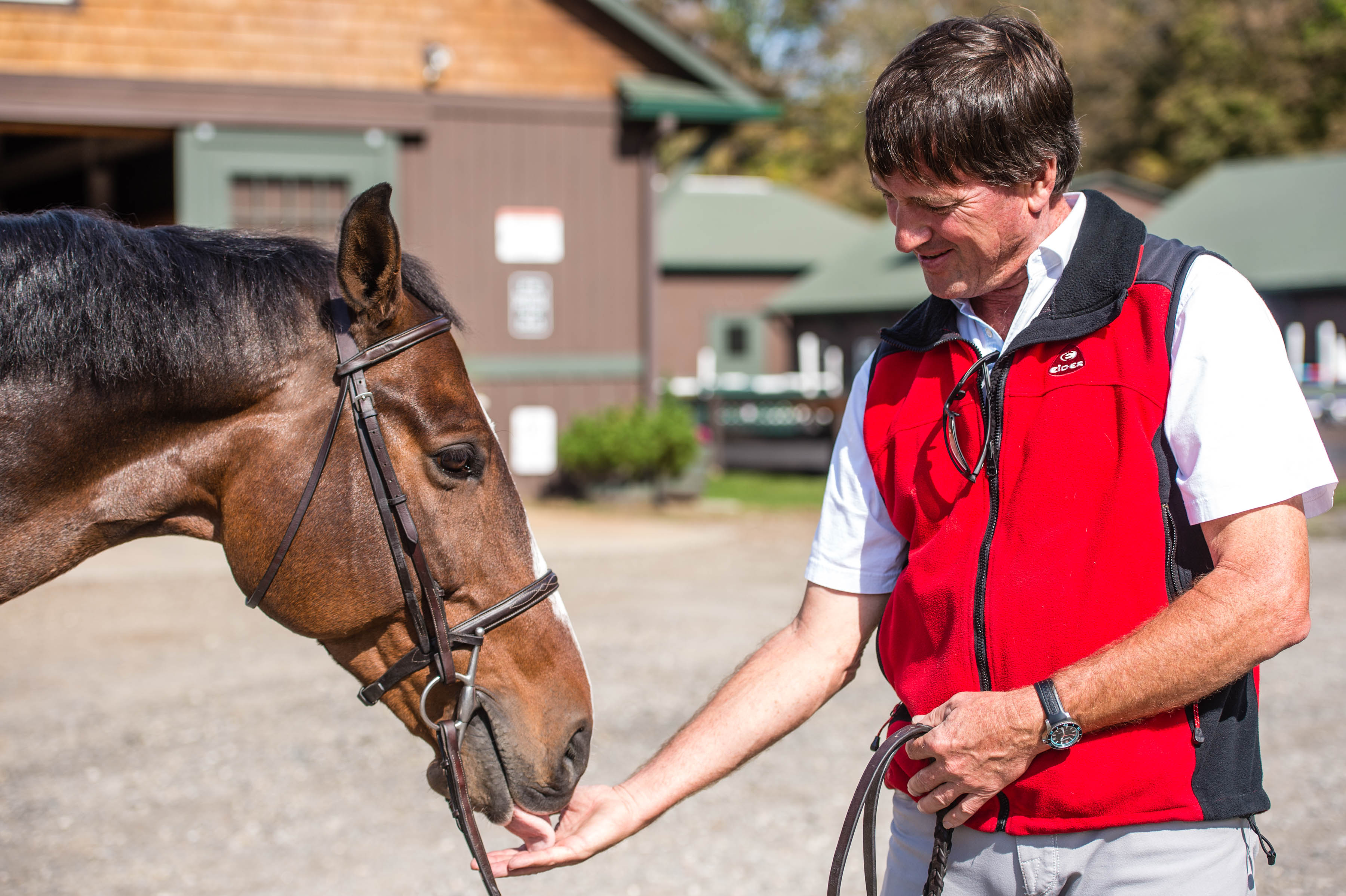
Riding my grand prix partner Captain in this fall’s $100,000 Truman Homes Cup CSI*** in Calgary, Alberta, I was faced with a striding decision. One line was a wall followed by six strides to a triple combination. Captain jumped the wall great, but when he landed I felt the need to add a stride in the line. I held him for seven strides, and he ended up being the first horse in the class to jump clear. (We eventually finished seventh.) Decisions like this don’t always work out, but by training your instincts at home, you will be better able to make split-second corrections.
One of the courses I use at home to help hone rider instincts may sound a bit simple: a small gymnastic, a diagonal line, a bending line and an in-and-out. But I love its versatility. You can leave it in your ring for many days without running out of new ways to use it. And there are so few jumps that you can do your flatwork around them on days when you’re not jumping.
This setup offers a few single fences to get your horse going, yet it has enough jumps to put together a course or work on specific skills. Its many options give you the flexibility to safely increase or decrease the challenge depending on your and your horse’s level. Plus, it gives you both new skills to work on daily. You can do as little or as much as you or your horse need during each session and increase the difficulty when you’re ready.
See also: Sharpen Your Show-Jumping Skills
While it’s not a show-ring course, this schooling setup contains many of the same questions you’d encounter in the show ring. But the beauty is that, unlike in the competition arena, where you get one chance to get it right, you can work on pieces again and again and take your time to perfect them. Then you can test yourself by trying to do them right the first time another day.
Its variety of questions will train you to feel what you need to do without having to think about it. Other skills the setup improves include rhythm, balance, straightness, control and adjustability.
First, I’ll walk through the setup and basics, and then I’ll offer suggestions for how you can increase the difficulty and utilize all this course has to offer as you progress.

Setting Up
You can set this course up outdoors or indoors. Build the gymnastic on one long side of your arena from either two ground poles spaced 4-foot-6 apart or a placing pole or cavalletti (set at its lowest height) with 9 feet to a crossrail. On the other long side, create a one-stride in-and-out with a vertical and oxer 23½ feet apart. Then set up a six-stride (84-foot) bending line on one diagonal and a five-stride (70-foot) straight line on the other diagonal, each with a vertical and an oxer.
If your ring is too small to fit these lines, you can decrease the distances in 12-foot increments. I don’t change the distances for different horses or fence heights. Instead, I want to teach horses and riders to adapt to the striding as set. This will help them learn to solve questions in the show ring. If you can jump out of a medium stride, moving up or waiting is subtle. On the other hand, if you’re too slow to the jumps, you have to chase—and generally adjustments are much more severe. Ponies can always add a stride if needed.
Because this setup is meant to be versatile, the jumps can be set to approach from either way, depending on which part of the course you’re working on. To create lines that are jumpable from either direction, make your oxers square. Help less experienced horses and riders judge the takeoffs by adding ground lines on both sides of the jumps. For more advanced riders, you can leave some or all of the jumps without ground lines.
Trotting the simple two-pole (or pole-to-crossrail) gymnastic is a great exercise for riders and horses of all levels. Riders are programmed to look for distances to jumps. However, you cannot look for a distance when trotting two poles on the ground or a pole to a crossrail because the distance is predetermined. Instead, you need to rely on rhythm and balance. Repeating this exercise is a good way to help develop those qualities.

Starting Out
Start by warming up your horse on the flat. Once he is balanced and going forward and coming back well on a straight line, trot over the ground poles. Eventually progress to trotting the placing pole to crossrail.
As you jump the crossrail, concentrate on your landing by staying in the middle of your horse and cantering away straight and in balance with control before making a smooth turn looking in the direction you’re headed. Come back to the trot after completing the turn or earlier if needed to regain balance and control. Repeat the exercise in the same direction until you and your horse are comfortable doing it and your horse remains balanced and in control without anticipating.

Once you have that down, ride the gymnastic again, then continue cantering and pick up some single jumps at the far ends of the diagonal lines off both the left and right leads. These long gallops will open up your horse’s stride and get him going forward. They will also get you thinking forward.
Then bring your horse back to a trot and ride the gymnastic again before doing four or five more single jumps. Going from the gymnastic to a bit of a gallop and then reorganizing to the gymnastic again can be difficult, so this exercise helps to get your horse listening to you and forces you to focus on putting him together.

Learn Your Lines
Next, work on the lines. Practice cantering the straight line first. I have it set at 70 feet, which is a nice, safe, comfortable striding for most horses. By starting with this, you and your horse will get into a groove and establish a good rhythm and tempo. Again, keep him straight, stay in the middle of him and ride a good turn both before and after the line.
Whether you jump the line from vertical to oxer or vice versa depends on what you and your horse are practicing. For a more tentative rider, jumping the oxer first has the benefit of getting you thinking forward and your horse going more forward because he has to stretch over it. This is also generally easier because you can choose the pace and approach you want to the oxer and then adjust as necessary to the vertical. At worst, if the adjustment doesn’t work out, the horse might knock down the vertical. Ridden in the opposite direction, from vertical to oxer, the line is not always so forgiving. A rider not thinking forward after the vertical may have trouble getting out over the oxer.
When the straight line is going well, canter the bending line. Bending lines present a variety of challenges for different levels of riders and horses. Beginner and intermediate riders sometimes find this exercise much harder than simply cantering two jumps on a straight line, where there is only one correct track to ride. These riders should focus on approaching from a normal stride and perfecting the exercise before beginning to adjust striding and track. A more advanced rider finds bending lines easier to navigate because there’s more space to play with, and she can use that space to make adjustments by changing her horse’s stride length or altering her track, depending on how her horse jumped into the line and other variables.
As you and your horse advance, play with the striding between jumps in the lines (for example, ride the bending line in five or seven strides and the straight line in four or six strides.)
Finally, practice cantering the one-stride combination, making sure your horse stays straight and in control without anticipating.

Put It All Together
As you progress through these different questions and your horse becomes more adjustable, you can put them together in courses using the same jump setup. Start out simply, the same way you introduced each of the parts: with the straight lines first, then the bending line, then the in-and-out. For example, begin by trotting the gymnastic placing pole to the crossrail, canter the vertical-to-oxer straight line off the right lead in five strides, make a left turn to canter the bending line—oxer to vertical—in six strides, then turn right to finish over the in-and-out.
Start every course by riding an opening circle, the same way you would in a show ring, to set yourself up. Get your pace first and set the tempo to the first jump. Every horse is different, and as the rider, it’s your job to know what your horse needs. Make that part of your daily practice so it comes naturally when you’re faced with the pressure of the competition ring.
See also: Gymnastics from Olympian Beezie Madden
When this course is riding well, change the order of questions around to create new courses—for example, straight line to gymnastic to bending line to in-and-out. In future sessions, get even more creative, throwing in occasional single jumps (from either the beginnings or ends of the lines) for variety. Maybe move the in-and-out earlier in your course or jump it off both leads. At this point, you can also introduce new types of jumps, such as walls or gates, that you might see in the show ring or that you or your horse need to get more confident over.
As you progress, add in tighter turns (such as inside turns) or angled jumps. Get creative. For example, make singles out of both jumps of the in-and-out (ensuring you jump only the “out” in whatever direction you’re going—you don’t want the horse to learn to run out by angling over the “in” and skipping the “out”).
As you can now see, this “simple” course can be as easy or hard as you want to make it, and there are infinite ways you can incorporate it into your everyday training to increase your success in the show ring.
ABOUT ERIC HASBROUCK

Eric Hasbrouck started riding in Washington state when he was 8 years old. Instead of roping cows like other riders in his area, he wanted to jump, so he began taking lessons from Fran Berry, formerly of Sweet Briar College, in Virginia.
Eric has competed in and won almost every grand prix in America over his career. He began riding for the U.S. show-jumping team in the mid-1990s, and his first team victory came at the Washington International Horse Show in 1995. The highlight of his career was making the team for the 1998 World Equestrian Games in Rome, riding Freestyle.
Eric went on to train various riders and design show-jumping courses across the United States, Canada and Europe. His business, Cascade Enterprises, is based out of North Salem, New York, and Calgary, Alberta, and he continues to teach and compete up to the grand prix level.










